
European Autochrome
“When the World Turned to Color ” — 20th exhibition of Šechtl & Voseček Museum of Photography.
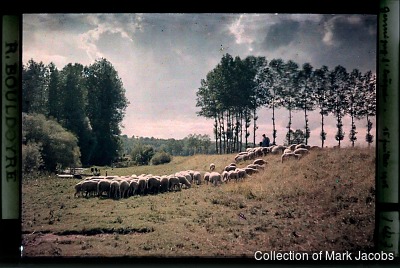
-
“Germigny l’Evêque 15 juillet 1908”.
Raymond Bouldoyre
Autochrome 9 × 12 cm,
Owner of the original autochrome: Collection of Mark Jacobs All rights reserved, use of the digital reproduction is possible only with written permission from the owner of photographLittle is known about this photographer except that he used and became quite proficient with the Autochrome process almost immediately after their commercial introduction in June, 1907. Of the approximate twenty or so plates that are known to exist by Bouldoyre, about half are mono with the remainder in stereo format. The photographer was careful to label, date, and identify the location of each plate, often including exposure times. Such detail suggests the work of a serious amateur photographer. His photographs are landscapes from the environs of Paris, Brittany, Normandy, and the Île- de- France region. They are marked by an Impressionist atmosphere that is in line with Autochromes from the same era such as those by Charles Adrian, Antonin Personnaz, and Léon Gimpel.
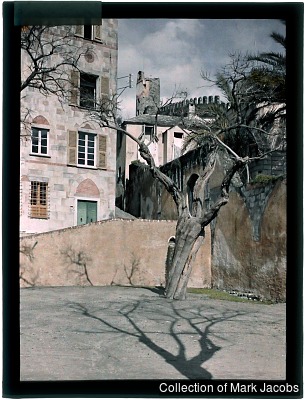
-
Tree and Shadow.
Louis John Steele (Active 1900’s – 1920’s)
Autochrome 4 ¾ x 3 ½ inches,
Owner of the original autochrome: Collection of Mark Jacobs All rights reserved, use of the digital reproduction is possible only with written permission from the owner of photographSteele was a member of the Portsmouth Camera Club and the Royal Photographic Society of Great Britain. A serious amateur photographer, Steele photographed street scenes in Italy as well as in Great Britain. Though his color work primarily consists of autochromes, Steele did produce images using the first Dufay color process. This striking composition is noteworthy for the photographer’s awareness and use of shadows—something which would become a hallmark of black and white photography during the 1920’s and 1930’s.
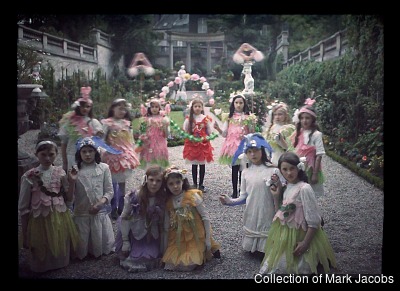
-
Scene from a Garden Party.
Photographer Unknown
Autochrome,
Owner of the original autochrome: Collection of Mark Jacobs All rights reserved, use of the digital reproduction is possible only with written permission from the owner of photographOne wonders if the historian of Autochromes John Wood, writing in his book, Art of the Autochrome, had this particualr image in mind when writing of the autochrome:
“It is as if they possess a kind of Proustian power, an ability to waken in us and summon up our collective memory-or possibly a collective mythology-of a gentler past, a world before sarajevo and the Somme, and long, long before Dachau and Auschwitz, Dresden and Hiroshima, before all the horrors of a world less suffused in such idyllic light....autochromes are the color of dreams,and the real world was always harsher than they would suggest or was, but that is not the way we would have it. A nostalgic longing for a yesterday sweeter than today...the autochrome is our visual madeleine, and it lets us slip back to where we never were and to what never was.”
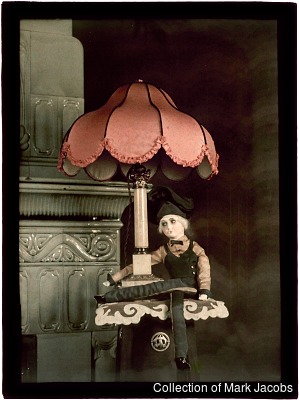
-
Doll and Table Lamp.
Unknown Photographer (German)
Autochrome 9 × 12 cm,
Owner of the original autochrome: Collection of Mark Jacobs All rights reserved, use of the digital reproduction is possible only with written permission from the owner of photographOne of the strangest Autochromes in the collection. Note the cigarette dangling from the mouth of the doll. This is no longer simply a child’s toy doll but something if not peculiar then almost sexual in nature. Her pose, legs crossed but relaxed, is suggestive of emancipation from the monotony of domesticity. She is illuminated only by the color of the shade of the lamp, while the lamp itself appears isolated as if it only existed on some nameless street corner in Berlin.
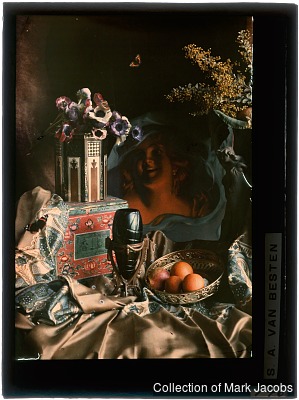
-
Still Life.
Alfonse Van Besten (–)
Autochrome 9 × 12 cm,
Owner of the original autochrome: Collection of Mark Jacobs All rights reserved, use of the digital reproduction is possible only with written permission from the owner of photographVan Besten was a Belgian autochromist and painter who took full advantage of the possibilities of the new colour process. This extraordinary still life evokes the mature aesthetics of Surrealism, something quite unique for the still life genre, especially those photographed in Autochrome. Typically, Van Besten’s work centered around images of women posed in allegorical way and in elaborate costumes. During the World War I he was a refugee in Holland. While there, he gave countless lectures at Dutch photographic societies.
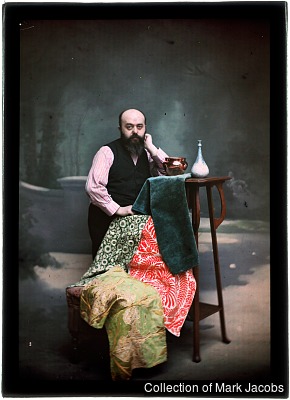
-
Tailor.
Photographer Unknown
Autochrome 13 × 18 cm,
Owner of the original autochrome: Collection of Mark Jacobs All rights reserved, use of the digital reproduction is possible only with written permission from the owner of photographThe tailor appears to us to be quite ordinary. He is seated at a work table, his only accouterments are bottle and a copper pot. He is situated outside of a work environment, an occupational portrait, but isolated from the normal tools of his trade. Monochromatic but for his red and white striped shirt. Dark pants, dark vest, dark beard and dark eyes and yet from such darkness emerges the most beautiful fabrics, lush but supple cloths intended for fabulous dresses. The name of the sitter is now lost to us as is the maker of this subtle image. What is known is that there are two variations of this French Autochrome—one in which the tailor is looking down upon the fabric and this image where he is facing the camera.
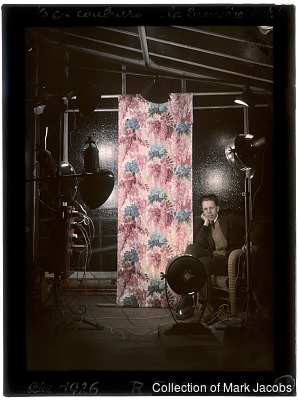
-
“Photo in Color in the Artificial Light”.
Robert Dasché (–)
Autochrome 9 × 13 cm,
Owner of the original autochrome: Collection of Mark Jacobs All rights reserved, use of the digital reproduction is possible only with written permission from the owner of photographDasché was the long-term president of the Photo-Club Rouennais (Rouen) from 1941 – 1963. This Photo-Club was active in promoting competition with other clubs using the Autochrome beginning in 1908. It is quite likely that Dasché learned the process from a family member, quite possibly his father, since a group of approximately thirty plates are known to exist and are attributed to a Dasché but which date from about 1910.
This Autochrome is probably a self-portrait, which is very uncommon. What makes this image particularly unique is that it was photographed inside a photographic studio—quite possibly inside the studio of the Photo-Club itself. The image appears almost monochromatic except for the background. Thus, in an unusual turn of pictorial convention, the background itself becomes the subject of the photograph while what is normally the subject is relegated to the background.
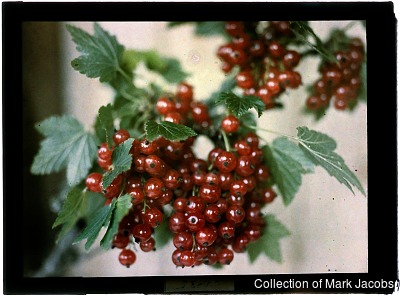
-
Red Currant.
Karel Šmirous (–)
Filmcolor 13 × 18 cm,
Owner of the original autochrome: Collection of Mark Jacobs All rights reserved, use of the digital reproduction is possible only with written permission from the owner of photographKarel Šmirous was a successful photographer in addition to a distinguished career as a scientist. His photographs are not only technically proficient, but are notable for their composition and use of color. From his early experiments with color, he developed a style with careful choice of colors, often using only variants of a single dominating color. His work is thematically rich—he photographed still life, portraits, nudes, landscapes, reportages, advertisements and scientific photography. The collection of several hundred Autochromes preserved from his work comprises the largest Czech Autochrome collection. Part of the collection was exhibited at the National Technical Museum in Prague, to celebrate the 90th anniversary of Autochrome in 1997.